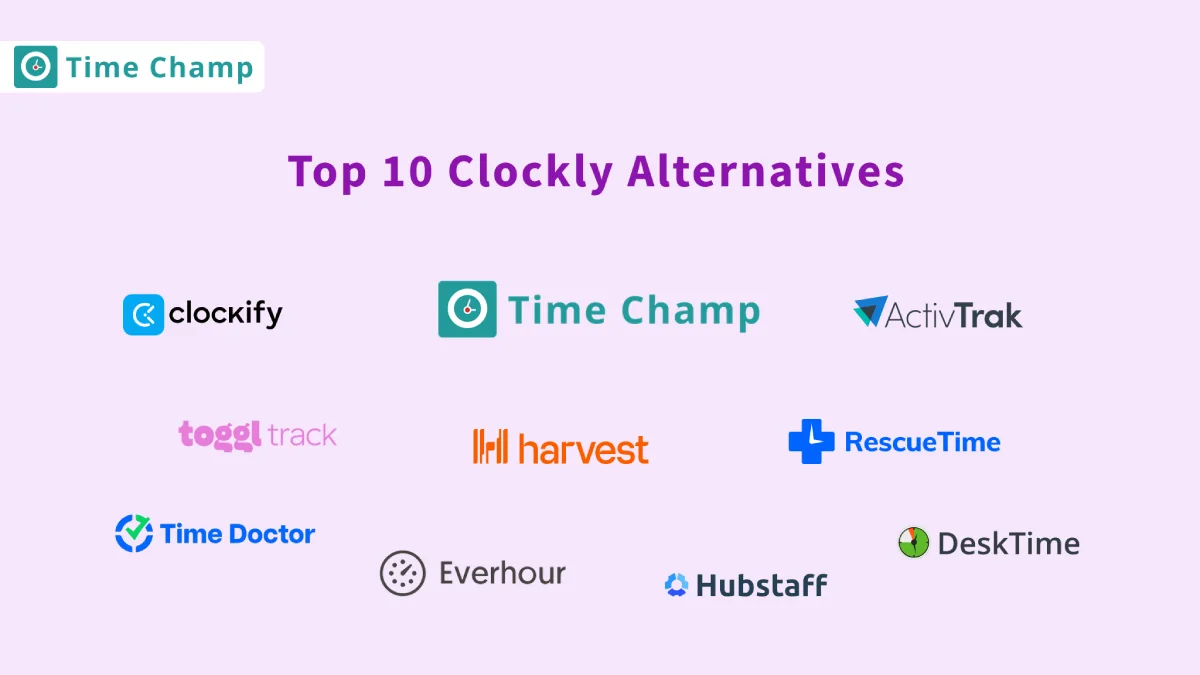Is Clockly falling short of your expectations? Don’t worry
If your current time tracking tool feels clunky, confusing, or simply not keeping up with your workflow, you're not alone. Whether it's missing features, unclear reports, or scalability issues, it's a sign to look beyond Clockly.
In this blog, we’ve rounded up the top 10 Clockly alternatives that go beyond just tracking hours. These tools help you optimize productivity, manage teams better, and actually get time on your side.
Why Clockly Users are Searching for Better Alternatives?
Clockly handles the basics, but for many teams, that’s not enough. Some users say it’s hard to use, especially for people who aren’t very tech-savvy. Even simple things, like starting or stopping the timer, can feel harder than they should be because of the confusing layout. That steep learning curve can slow teams down instead of helping them move faster.
Clockly is fine, but it doesn’t work as well when teams need more options. You can’t customize it much, and it doesn’t connect easily with other tools. For small teams, it might be okay at first, but as the team grows and needs change, Clockly can’t always keep up.
That’s why many users start looking for something more powerful. A tool that’s easier to use, but also more adaptable. One that doesn’t just track time, but helps you truly understand how it’s being spent. If you're searching for something better, you're already ahead of the game.
Key Features of Clockly
1. Time Tracking helps to analyze how much time is spent on each client, project, or task.
2. Employee Monitoring tracks real-time activity using screen captures, location, clicks, and keystrokes to boost productivity.
3. Online Timesheets track and record employee work hours daily, weekly, and monthly in one central place.
4. Activity Tracking helps to monitor keystrokes, mouse clicks, and manually entered work hours and sick days in one unified dashboard.
Drawbacks of Clockly
Clockly is an effective time tracking and employee monitoring tool yet may not be the most suitable solution in fast-growing or flexible teams. The following are some of the problems that have been reported by users:
1. Manual Input Burden
Certain functions of Clockly presuppose manual input of data, including recording location-based activity or sick days. It is a time-consuming process and likely to cause human error, which can impact the quality of records and reporting.
2. Limited Offline Functionality
Clockly’s performance can be limited without a stable internet connection. This can be a significant disadvantage to remote employees, field teams, or users who frequently encounter low connectivity areas
3. User Experience Challenges
The user interface and the experience of Clockly are less intuitive in some user experiences than other tools. Specifically, new users might find it difficult to set up and navigate, which will impede the adoption rate and efficiency in the onboarding process.
4. Limited Integration Options
Clockly may not support seamless integration with all third-party tools or platforms, especially niche project management, HR, or payroll systems. This may lead to either additional manual efforts or workarounds, decreasing workflow efficiency.
5. Basic Reporting Features
Clockly provides simple tracking reports, and its analytics might not be sufficient for teams that require in-depth insights or trends. Businesses seeking detailed productivity metrics or long-term performance tracking may find the features lacking.
10 Best Clockly Alternatives You're Probably Overlooking
| Software | Key Features | Pricing | Rating |
|---|---|---|---|
| Time Champ |
|
|
|
| Clockify |
|
|
|
| Hubstaff |
|
|
|
| Toggl Trak |
|
|
|
| Time Doctor |
|
|
|
| Harvest |
|
|
|
| ActivTrak |
|
|
|
| DeskTime |
|
|
|
| RescueTime |
|
|
|
| Everhour |
|
|
|
If you're ready for something smoother or more flexible, these 10 alternatives are worth a look.
1. Time Champ
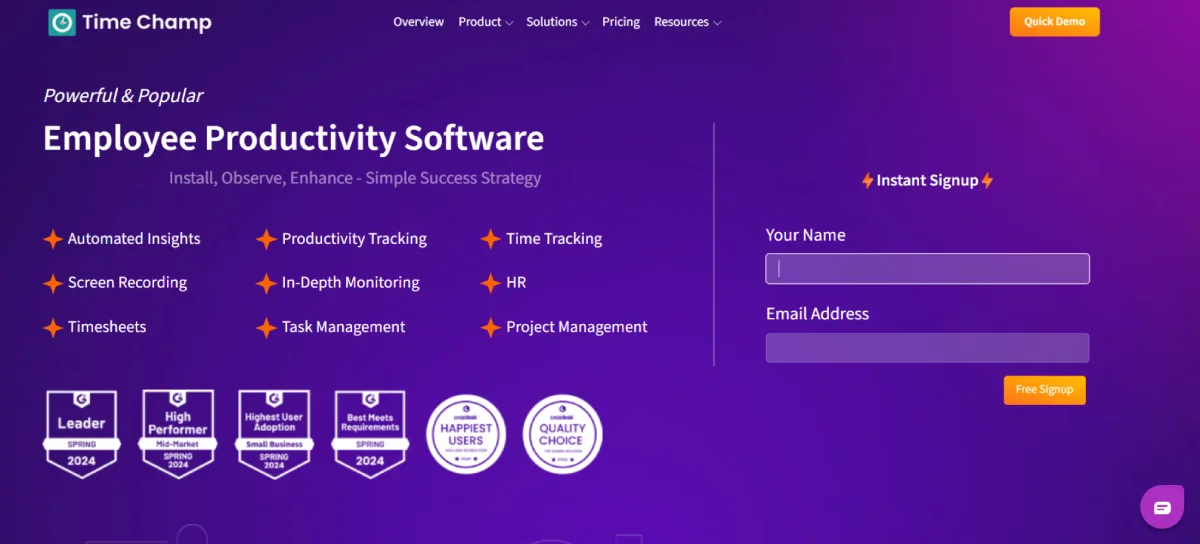
Time Champ is an efficient workforce analytics and time tracking platform built to boost productivity and streamline operations for teams of all sizes. It offers essential features like automatic and manual time tracking, employee attendance management, and real-time performance insights. With powerful tools for activity monitoring, reporting, and seamless integrations, Time Champ helps organizations gain visibility into work habits, enhance accountability, and make smarter, data-driven decisions across remote, hybrid, and in-office teams.
Key Features
- Live monitoring lets you see screens in real time, take automatic screenshots, and record screens at set times to keep everything visible and clear.
- Project management makes it easy to assign tasks and projects. It includes tools like goal tracking, bug tracking, sprint planning, and calendar views.
- Time tracking automatically records work hours, creates accurate timesheets for payroll, and works offline for employees in the field.
- App & Website usage shows reports on apps and websites employees use during work, helping spot how time is spent and find possible risks.
- Productivity reports give useful insights by day, week, or month, for individuals or the whole team, helping you improve how work gets done.
- Screenshots capture work progress at regular, customizable intervals to ensure transparency and accountability.
- Automated attendance logs clock-in and clock-out times, calculate total work hours, and keep accurate attendance records.
Pros:
- Detailed time tracking with idle detection, live monitoring, and productivity metrics.
- Built-in project management with task tracking and real-time dashboards.
- Auto-generated timesheets, screenshots, and app usage reports for oversight.
- Affordable pricing with responsive support and customization options.
Cons:
- Steep learning curve for advanced features and reports.
- Occasional lag or inaccuracies in live streaming and idle tracking.
- Lacks auto-pause during inactivity like meetings.
Pricing
- Starter: $3.9/User/Month
- Professional: $6.9/User/Month
- Enterprise: $13.9/User/Month
Ratings
- G2: 4.8
- Capterra: 4.9
2. Clockify
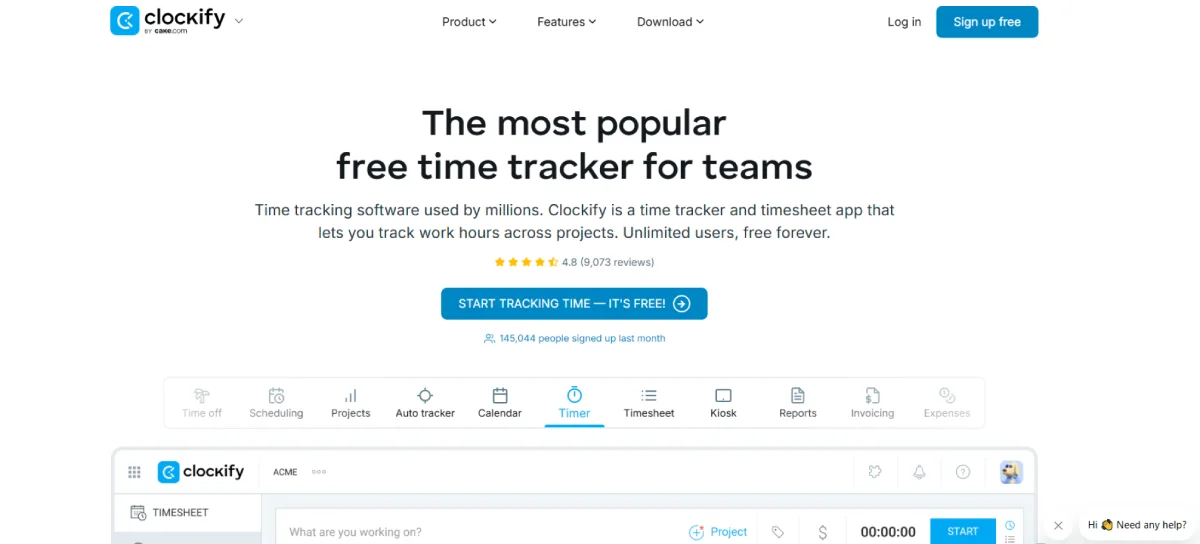
Clockify is a time tracking and productivity app that works well for teams of all sizes, even for freelancers and people working from home. It has features like manual and automatic time tracking, logging time by project, and easy timesheet management. It also offers reports and connects with popular tools to help teams stay organized and productive during the workday.
Key Features
- Timesheet helps to track productivity by showing total time logged per day, week, and activity.
- Auto tracker records the time you spend on different apps and websites without needing to start or stop anything.
- Offline mode allows you to track your activities without an internet connection.
- Review locations let you view job sites visited and replay the routes taken throughout the day.
- Invoicing helps you create bills from your tracked time and work expenses.
Pros:
- Offers free time tracking with unlimited users and projects.
- Simple interface that’s easy to use for individuals and teams.
- Supports project, client, and team tracking with basic reporting.
- Integrates with tools like Trello, Asana, and Slack for better workflow management.
Cons:
- Limited offline support for remote work.
- Key features locked behind paid plans.
- Some users report bugs and sync issues in the app.
Pricing
- Standard: $5.49 per seat/month billed annually
- Pro: $7.99 per seat/month billed annually
- Enterprise: $11.99 per seat/month billed annually
Ratings
- G2: 4.5
- Capterra: 4.8
3. Hubstaff
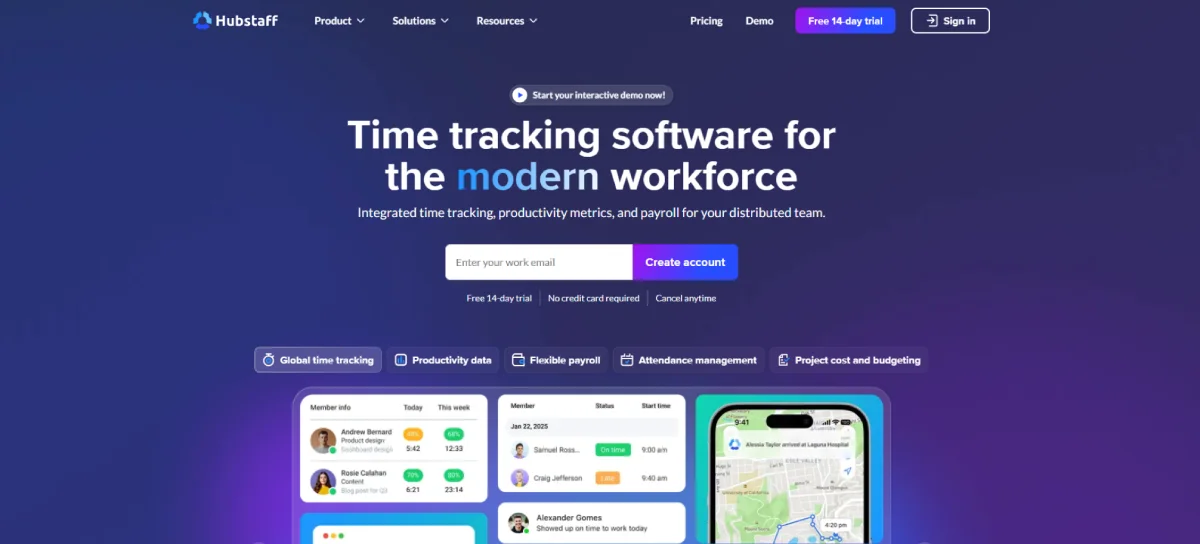
Hubstaff is a time tracking and productivity tool built for remote and distributed teams. It has features such as time tracking, activity tracking, and GPS tracking. Hubstaff also supports tasks, timesheets, and simple reporting that allows teams to be on track and more efficient in their work.
Key Features
- Expense and invoice management help simplify the billing process by tracking the expenses of the project and automatically generating the invoice.
- Attendance management lets you view who’s working, on break, or offline to manage schedules efficiently.
- Automatic timesheets capture accurate work hours and simplify approvals.
- GPS tracking offers real-time location information to update managers.
pros
- Easy-to-use interface designed for both individuals and teams.
- Supports tracking by project, client, and team with basic reporting features.
- Integrates with Trello, Asana, Slack, and more for streamlined workflow management.
- Mobile and desktop apps for easy time tracking anywhere.
Cons
- Limited features on the free plan compared to paid tiers.
- Steep learning curve for advanced features.
- Limited customization, especially in reports.
Pricing
- Starter: $4 per seat/month (2-seat minimum)
- Grow: $7 per seat/month (2-seat minimum)
- Team: $10 per seat/month (2-seat minimum)
- Enterprise: $25 per seat/month (2-seat minimum)
Ratings
- G2: 4.5
- Capterra: 4.6
4. Toggl Track
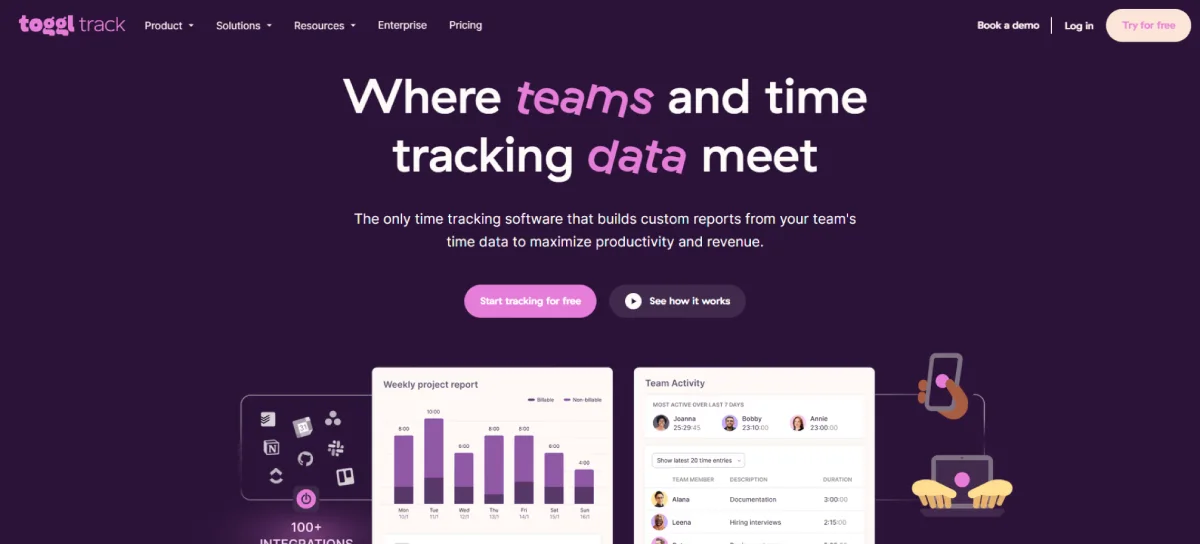
Toggl Track is an easy-to-use time tracking tool made for individuals, freelancers, and teams of any size. It offers simple, one-click time tracking, along with features like project management, detailed reporting, and integrations with popular work tools. With its intuitive interface and flexible tracking options, Toggl Track helps users gain insights into how time is spent and improve overall productivity.
Key Features
- Offline tracking lets you record time without internet and sync later for convenience.
- Timeline auto-tracks app and browser activity to create an accurate work record.
- Project dashboard shows your project progress, helps manage time and budget, and makes it easy to see how things are going.
- Timesheets simplify tracking of both paid and unpaid hours using a quick one-click timer.
pros
- Desktop and mobile access for flexible time tracking.
- Customizable reports and categories for productivity insights.
- Tracks billable/non-billable hours with Outlook sync.
- Intuitive interface for easy project and time management.
Cons
- No built-in tutorials make setup and upgrade decisions harder.
- Reports don’t load without the Internet, frustrating in low-connectivity areas.
- Limited color options, hard-to-delete projects, and time entry glitches affect usability.
Pricing
- Free: $0 Free for up to 5 users.
- Starter: $9 per user per month.
- Premium: $18 per user per month.
Ratings
- G2: 4.6
- Capterra: 4.7
5. Time Doctor
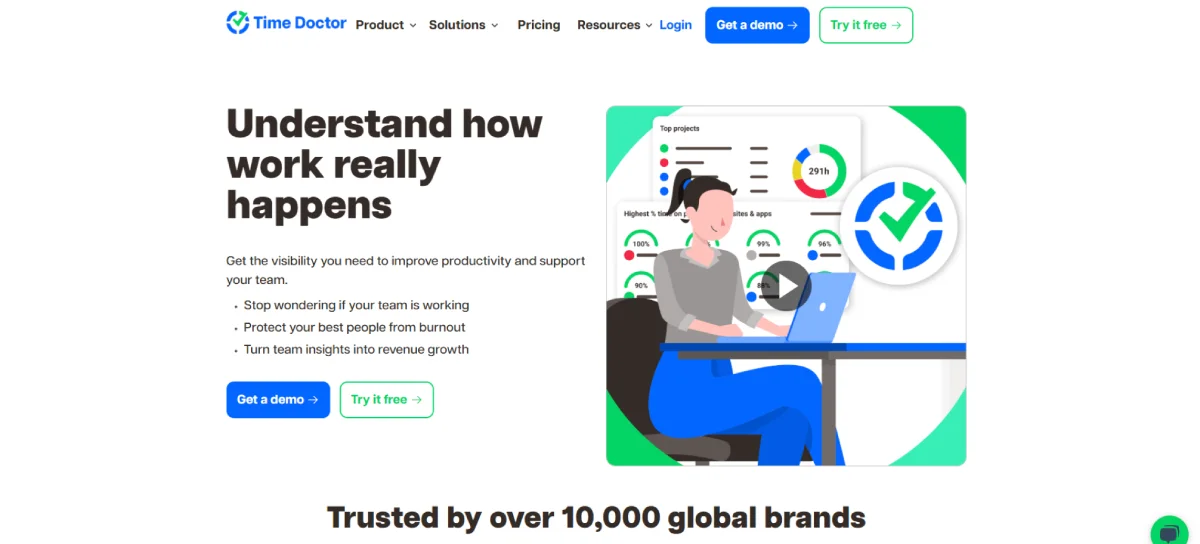
Time Doctor is a cloud-based employee monitoring and time tracker running on Windows, macOS, Linux, iOS, and Android. It aids in monitoring working hours, activity, and application/website usage- both desktop and mobile application. It is beneficial to remote teams and organizations that seek to enhance productivity and hold everyone accountable.
Key Features
- Attendance tracking helps automate tedious tasks and ensures your teams are consistently showing up.
- Work scheduling enables you to build work schedules and compare them to worked hours.
- Inactivity alerts help you instantly know when employees lose focus and help them to get back on track.
- Unusual activity reports use AI to catch irregular mouse clicks and keystrokes, helping ensure accurate time tracking.
pros
- Screenshots make monitoring work easy.
- More affordable than similar software.
- Tracks time on websites and programs for better management.
- Easy to start with a handy clockable widget.
Cons
- Searching for projects and tasks is difficult.
- Idle time and sidebar often don’t display.
- Limited customer support, so users must self-diagnose issues.
Pricing
- Basic: $6.70 per user/month
- Standard: $11.70 per user/month
- Premium: $16.70 per user/month
- Enterprise: Custom plan
Ratings
- G2: 4.4
- Capterra: 4.5
6. Harvest
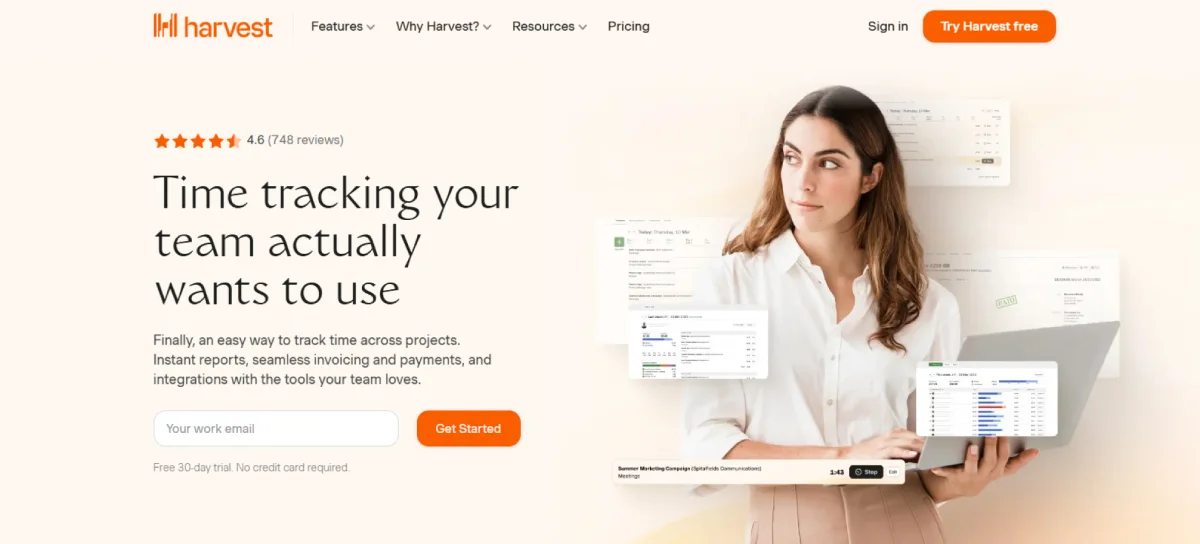
Harvest is an easy-to-use online tool made in 2006 that helps track time, manage expenses, and send invoices. Harvest integrates with many tools, apps, and web services so teams can quickly adopt and integrate it into their usual workflow without any complexity or major adjustments.
Key Features
- Project reporting helps track budgets and costs to understand profitability.
- Project management helps to set budgets, track real-time spending, and alert teams as costs approach limits.
- Time management helps your team see how they spend time to improve efficiency and set better boundaries.
- Invoices from timesheets help convert tracked billable hours into online invoices automatically.
pros
- Quick to learn and set up for invoicing.
- Effective start/stop timer on desktop and mobile.
- Clear, easy-to-send reports and invoices.
- Allows editing of past time entries.
Cons
- No PO number field, requiring manual invoice entry.
- Hard to manage many clients/projects due to limited search.
- Limited features and relatively high pricing.
Pricing
- Free: $0 free forever
- Pro: $11 per seat/month
- Premium: $14 per seat/month
Ratings
- G2: 4.3
- Capterra: 4.6
7. ActivTrak
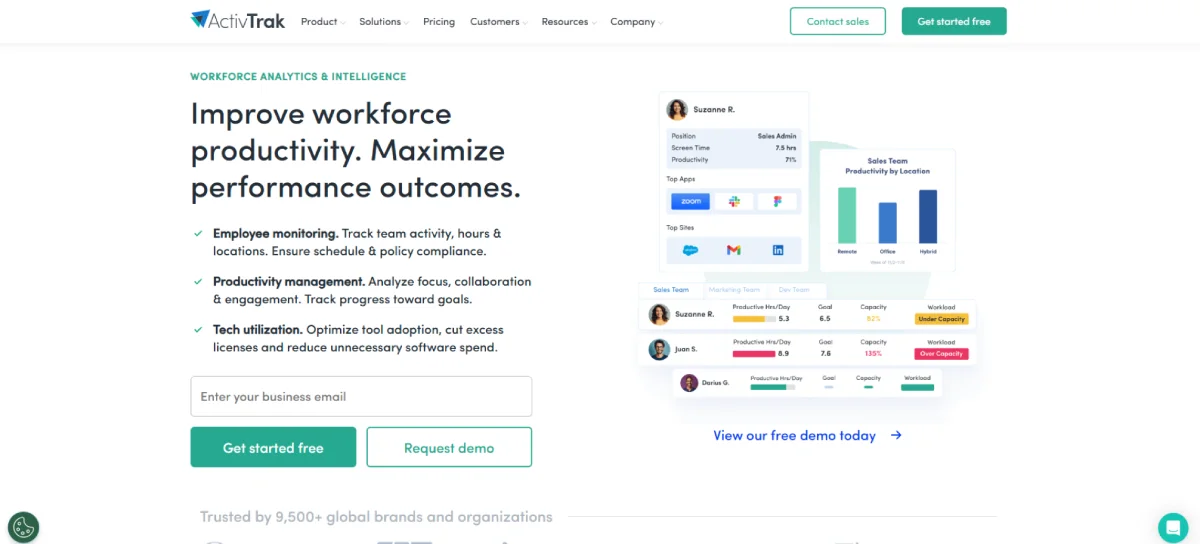
ActivTrak is a workforce analytics tool that can be used to track employee activity in real-time and analyse data relating to employee productivity. It captures user interactions, application usage, and provides insights via dashboards and reports. The software is compatible with Windows, macOS, and virtual desktop infrastructures.
Key Features
- Time tracking records work hours for accurate task insights and schedule adherence.
- Activity alarms alert on undesirable behaviors and compliance risks in real time.
- Activity alignment highlights time spent on high-value tasks over low-impact ones.
- Productivity reports provide real-time team performance and workload insights to boost efficiency.
pros
- Easy to set up and deploy across users or machines.
- User-friendly interface with detailed event logs.
- Useful for managing remote teams and monitoring productivity.
- Regular feature updates and responsive customer support.
Cons
- Can be difficult to drill down into data and slow at times.
- Customer service issues and unexpected fee increases reported.
- Installation inconsistencies and confusing UI for some admins.
Pricing
- Free: $0 per user/month
- Essentials: $10 per user/month, billed annually
- Essential Plus: $15 per user/month, billed annually
- Professional: $19 per user/month, billed annually
Ratings
- G2: 4.4
- Capterra: 4.6
8. DeskTime
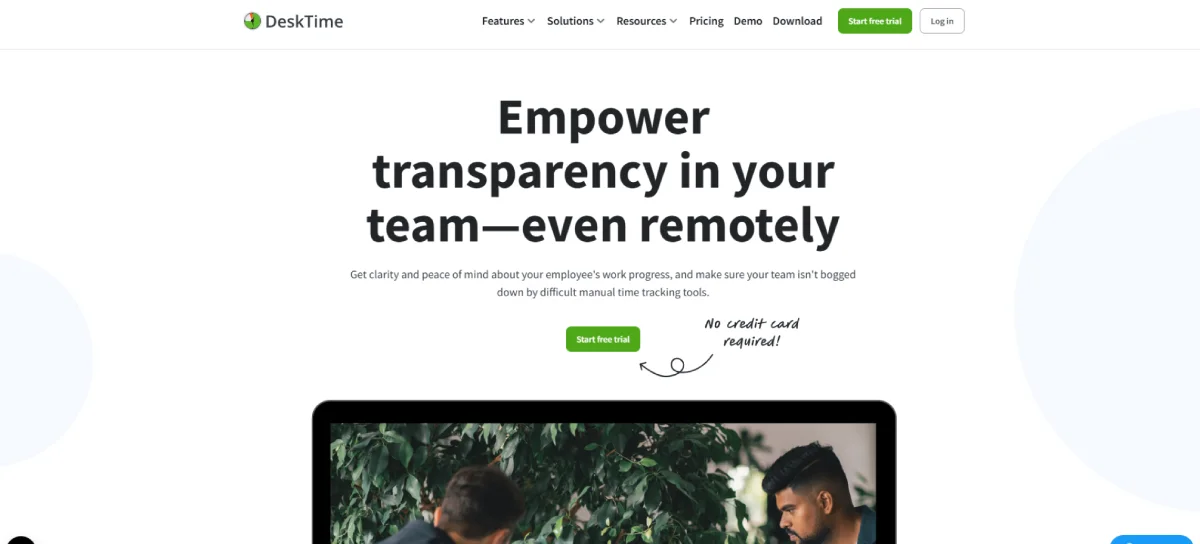
DeskTime is a time tracking tool that helps companies keep an eye on how employees spend their time and manage projects more easily. It offers both automatic and manual time tracking, shows which websites and apps are used, and gives simple productivity reports. It also works with tools like Asana, Trello, and Google Calendar to make work smoother.
Key Features
- Project tracking shows exactly how much time is spent on each task or project.
- URL and app tracking displays websites and applications used throughout the day.
- Performance evaluation analyzes tracked time to reveal what team members were doing, not just how long they worked.
- Scheduling helps organize work hours and manage absences for better team coordination.
pros
- Automatic time tracking offers clear task and project insights.
- Screenshots, reports, and mobile access support remote monitoring.
- Easy to use with smooth setup and reliable support.
- Helps assess productivity and reduce time-wasting.
Cons
- Relatively expensive for smaller teams.
- Occasional tracking inaccuracies and crashes.
- Limited support for Mac and Linux systems.
Pricing
- Lite: Free
- Pro: $4.25 per user/month
- Premium: $5.95 per user/month
- Enterprise: Custom (200+ users)
Ratings
- G2: 4.5
- Capterra: 4.5
9. Rescue Time
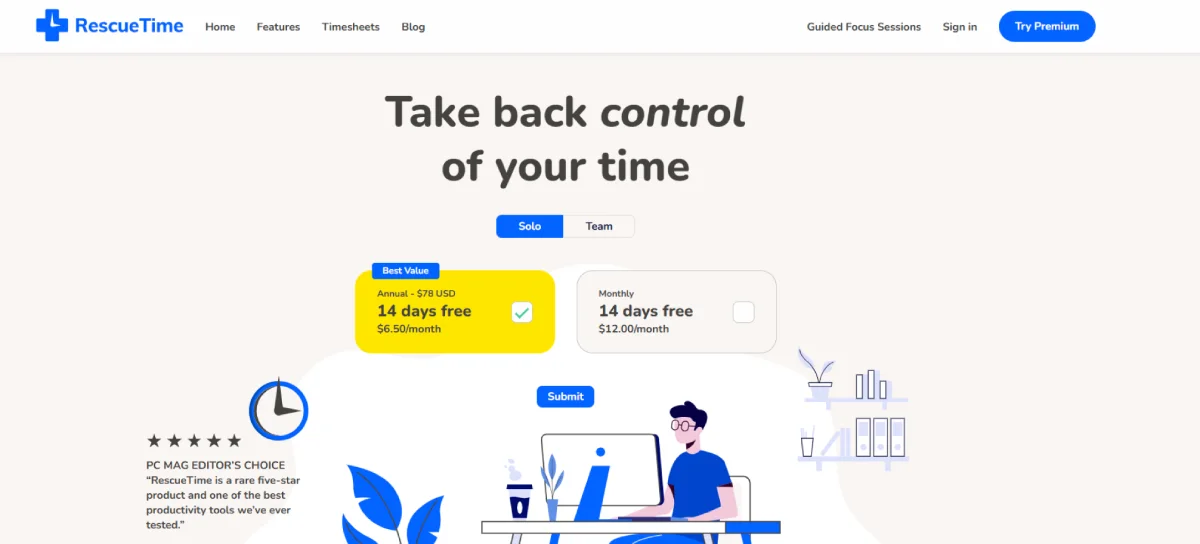
RescueTime is a time management software designed to help users track how they spend their time on digital devices. The tool includes features like goal setting and alerts, though its effectiveness depends on how consistently users review and act on the data. It's primarily useful for individuals looking to understand their work habits without manual tracking.
Key Features
- Automatic time tracking monitors app and website usage for a daily productivity overview.
- Website and app blocking blocks selected distractions during timed work periods.
- Alerts and notifications send a signal when productivity goals or time limits are reached.
- Timesheets use a visual timeline and drag-and-drop interface to simplify tracking billable hours and daily work.
pros
- Automatic background tracking provides accurate insights into app and website usage.
- Focus sessions help minimize distractions by blocking selected sites and apps.
- Clear weekly and daily reports with visual summaries improve time management.
- Easy to set up and use, with helpful alerts and goal-setting features.
Cons
- Privacy concerns due to continuous activity tracking.
- Customizing categories and labels can be time-consuming initially.
- Mobile and desktop apps sometimes lack full synchronization.
Pricing
- Solo - Monthly: $12.00/month
- Team - Monthly: $9/month/team member
Ratings
- G2: 4.2
- Capterra: 4.6
10. Everhour
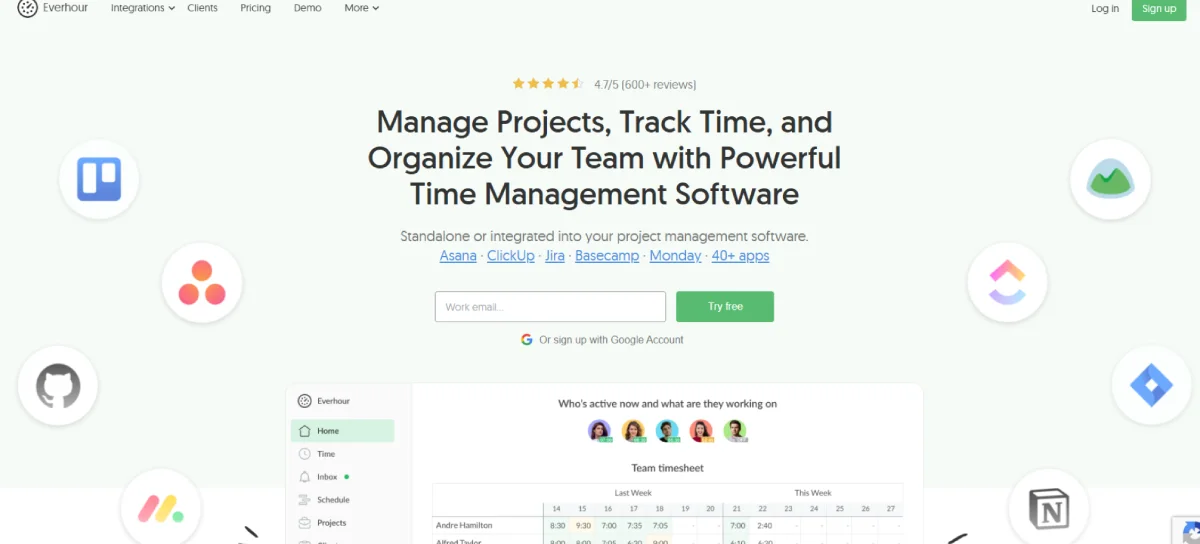
Everhour is a time tracking and project management tool that integrates with platforms like Asana, Trello, and Jira. It allows teams to log hours, track budgets, and generate basic reports. The interface is straightforward, and features like timesheets and invoicing are useful for managing client work. While it covers core functionality, its effectiveness depends on how well it's integrated into existing workflows.
Key Features
- Project management lets you create tasks, track time, and monitor progress in one place.
- Billing and budgeting options support fixed fee or recurring budgets to manage project costs.
- Detailed reports show time and money spent, individual progress, and overall project performance.
- Simple timesheets provide a clear view of team hours with approval and reminder features.
pros
- Smooth integration with tools like Asana, Basecamp, and Notion.
- Useful for tracking time against client budgets or hourly blocks.
- Easy-to-use browser extension for quick time logging.
- Built-in invoicing and reporting support client billing needs.
Cons
- Manual timer control can lead to tracking errors.
- Help docs are limited; users often rely on support.
- Depends on a browser extension for full functionality.
Pricing
- Monthly – Free: $0
- Monthly – Team: $10
- Yearly – Free: $0
- Yearly – Team: $8
Ratings
- G2: 4.7
- Capterra: 4.7
How to Select the Right Software for Your Team's Needs
We’ve looked at 10 other apps like Clockly, but if you’re still not sure which one to pick, don’t worry, I’ve got you covered. Time Champ is a good choice because it’s simple and has all the important features. You can track time, check attendance, and help your team work better, all without any confusion. Whether your team works from home or in the office, Time Champ helps you see what’s going on and stay organized. It’s an easy and smart tool that works well for many companies.
Final Thoughts
Choosing the right time-tracking tool depends on your specific business needs and team size. While there are many solid Clockly alternatives available, it’s important to prioritize ease of use, integration capabilities, and reliable support. Taking the time to evaluate these tools will help you find the most effective fit for your team.
Frequently Asked Questions
Most alternatives offer scalable plans, making them suitable for businesses of all sizes, from freelancers to large enterprises.
Trusted tools work hard to keep your data safe and private, but it's a good idea to check each company's rules and settings to make sure your information is protected.
Time Champ stands out with its simple interface, attendance management features, and seamless time tracking that suits both remote and in-office teams without overwhelming complexity.
Yes, and it's important to strike a balance. While features like screen capture and keystroke logging can increase accountability, they should be used transparently and ethically. Choose tools that allow customizable monitoring settings and inform your team about how and why the data is used.
Yes. You can use tracked data like how long tasks take, work patterns, and attendance to help review employee performance fairly, especially when you also include personal feedback.
Here are Some Related Articles You may Find Interesting

What is the Average Salary in Bangladesh: Overview & Insights
Discover The Average Salary in Bangladesh and outsourcing impact. Learn why it’s a rising player in global outsourcing.

Average Salary in India: Factors and Comprehensive Comparison
Discover the key factors influencing the average salary in India across industries, regions, and job levels, as well as insights.

What is the Average Salary in Colombia? & Factors Affecting
Discover the average salary in Colombia and explore the key factors affecting earnings, including industries, experience, and location. Find out.

What is the Average Salary in Indonesia?
Discover the average salary in South Africa and explore outsourcing trends. Learn key insights into wages, industries, and business opportunities.

What is the Average Salary in Hong Kong? and It’s Statistics
Learn about the average salary in Hong Kong, from minimum wage to maximum salaries, and gain insights into industry variations.

What is the Average Salary in Singapore: Economic Outlook
Discover the average salary in Singapore, key factors affecting income, insights into the nation’s economic outlook & explore its trends.
